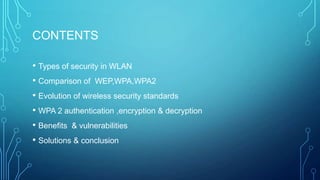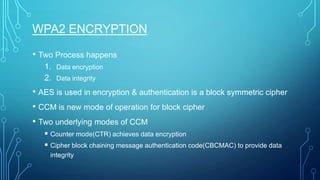Wireless security using wpa2
- 1. WIRELESS SECURITY USING WPA2 BY : TUSHAR ANAND KUMAR ECE-ŌĆØDŌĆØ, REGD. NO.: 1151016015
- 2. CONTENTS ŌĆó Types of security in WLAN ŌĆó Comparison of WEP,WPA,WPA2 ŌĆó Evolution of wireless security standards ŌĆó WPA 2 authentication ,encryption & decryption ŌĆó Benefits & vulnerabilities ŌĆó Solutions & conclusion
- 3. TYPES OF SECURITY IN WLAN ŌĆó OPEN : No security configured X ŌĆó WEP : Wired Equivalent privacy X ŌĆó WPA: Wi-Fi Protected Access ŌĆó WPA2: Advance Wi-Fi Protected Access
- 5. WPA2 OVERVIEW ŌĆó Wi-Fi Protected Access 2 ŌĆó Security standard developed by the Wi-Fi Alliance and is an implementation of IEEEŌĆÖs 802.11i ŌĆó Uses Advance Encryption Standard (AES) protocol ŌĆó AES in Counter-Mode for encryption ŌĆó AES in Cipher Block Chaining-Message Authentication Code (CBC-MAC) for integrity checking
- 6. WI-FI PROTECTED ACCESS 2 Table: two types of WPA2
- 7. COMPARING WEP, WPA ,and WPA 2
- 8. AUTHENTICATION Two types of authentication ŌĆó Personal mode ŌĆó Enterprise mode
- 9. PERSONAL MODE AUTHENTICATION ŌĆó Authentication performed between client and access point ŌĆó PSK(Pre Shared Key) & SSID(Service Set Identification) is used ŌĆó AP generates 256 bit from plain text pass phrase ŌĆó PMK(Pairwise Master Key) is generated after authentication
- 10. ENTERPRISE MODE AUTHENTICATION ŌĆó ŌĆó Based on IEEE 802.1x standard Authentication performed between :- 1. Client 2. Access Point 3. Authentication Server ŌĆó After authentication MK(Master Key) Is generated
- 11. WPA 2 KEY GENERATION ŌĆó 4 way handshake initiated by AP ŌĆó Confirms clientŌĆÖs knowledge of PMK in personal mode & MK in enterprise mode ŌĆó Pairwise Transient Key created at clientŌĆÖs ŌĆó Fresh PTK is derived at AP 1. Key confirmation key 2. Key encryption key 3. Temporal key
- 12. WPA 2 KEY GENERATION ŌĆó Install encryption and integrity key ŌĆó Control port are unblocked
- 13. WPA2 ENCRYPTION ŌĆó Two Process happens 1. Data encryption 2. Data integrity ŌĆó AES is used in encryption & authentication is a block symmetric cipher ŌĆó CCM is new mode of operation for block cipher ŌĆó Two underlying modes of CCM ’é¦ Counter mode(CTR) achieves data encryption ’é¦ Cipher block chaining message authentication code(CBCMAC) to provide data integrity
- 14. MESSAGE INTEGRITY CODE(MIC) ŌĆó IV(Initialization Vector) encrypted with AES & TK to produce 128 bit result ŌĆó 128 bit result is XOR with next 128 bits of data ŌĆó Result of XOR is continued until all IV are exhausted ŌĆó At end,first 64 bits are used to produce MIC Figure :AES CBC-MAC
- 15. WPA2 ENCRYPTION ŌĆó Counter mode algorithm encrypts the data with MIC ŌĆó Initialize counter for first time or increment counter. ŌĆó First 128 bits are encrypted using AES & TK to produce 128 bits. ŌĆó XOR is performed on result and first message block to give an first encrypted block. ŌĆó Repeat until all 128 bit of blocks has been encrypted. Figure: AES counter mode
- 16. WPA2 DECRYPTION ŌĆó It works in reverse using same algorithm for encryption the counter value is derived. ŌĆó By using the counter mode algorithm and TK , the MIC and decrypted data are found out. ŌĆó The data is processed by CBC-MAC to recalculate MIC ŌĆó If MIC does not match then packet is dropped otherwise data is sent to network stack and to client
- 17. BENEFITS OF WPA2 ŌĆó Provides solid wireless security model(RSN) ŌĆó Encryption accomplished by a block cipher ŌĆó Block cipher used is Advanced Encryption Standard (AES) ŌĆó IEEE 802.11i authentication and key management is accomplished by IEEE 802.1x standard ŌĆó Key-caching ŌĆó Pre-authentication
- 18. WPA2 VULNERABILITIES ’é¦ CanŌĆÖt stand in front of the physical layer attacks: ’ā╝RF jamming ’ā╝Data flooding ’ā╝Access points failure ’é¦ Vulnerable to the Mac addresses spoofing
- 19. PROCEDURES TO IMPROVE WIRELESS SECURITY ’é¦ Use wireless intrusion prevention system (WIPS) ’é¦ Enable WPA-PSK ’é¦ Use a good passphrase ’é¦ Use WPA2 where possible ’é¦ Change your SSID every so often ’é¦ Wireless network users should use or upgrade their network to the latest security standard released
- 20. FUTURE SCOPE ŌĆó A new standard IEEE 802.1W task group(TG) approved in March,2005 ’é¦ Main Goals Improve security by protecting the management frames and also being able to identify Spoofed management frames normally used to launch DoS attack
- 21. THANK YOU!
- 22. REFRENCES ŌĆó ŌĆ£Benefits and Vulnerabilities of Wi-Fi Protected Access 2 (WPA2)ŌĆØ Paul By Arana ŌĆó ŌĆ£The Evolution of 802.11 Wireless SecurityŌĆØ INF 795 - Kevin Benton ŌĆó ŌĆ£Wireless LAN Security Issues and SolutionsŌĆØ by Pan Feng at 2012 IEEE Symposium on Robotics and Applications(ISRA) ŌĆó Security Improvements of IEEE 802.11i 4-way Handshake Scheme by Xiaodong Zha and Maode Ma ┬®2010 IEEE






















